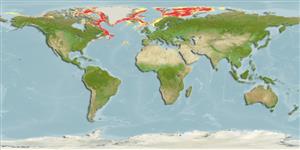Environment: milieu / climate zone / depth range / distribution range
Ökologie
seewasser bathydemersal; tiefenbereich 202 - 930 m (Ref. 34267). Deep-water; -1°C - 4°C (Ref. 34267)
Arctic, Northwest to Northeast Atlantic: north of Novaya Zemlya and northern part of Kara Sea (Ref. 4695); then from Greenland, Hudson Strait, north of Iceland, Faroe Islands, Svalbard and Laptev Sea (Ref. 34267).
Length at first maturity / Size / Gewicht / Alter
Maturity: Lm 16.0, range 14 - 18 cm
Max length : 23.2 cm SL Männchen/unbestimmt; (Ref. 11954)
Benthic; feeds on clams (Ref. 58426).
Life cycle and mating behavior
Maturities | Fortpflanzung | Spawnings | Egg(s) | Fecundities | Larven
Anderson, M.E., 1994. Systematics and osteology of the Zoarcidae (Teleostei: Perciformes). Ichthyol. Bull. J.L.B. Smith Inst. Ichthyol. 60:120 p. (Ref. 11954)
IUCN Rote Liste Status (Ref. 130435)
Bedrohung für Menschen
Harmless
Nutzung durch Menschen
Tools
Zusatzinformationen
Download XML
Internet Quellen
Estimates based on models
Preferred temperature (Ref.
123201): -0.1 - 4.6, mean 1.8 °C (based on 848 cells).
Phylogenetic diversity index (Ref.
82804): PD
50 = 0.5000 [Uniqueness, from 0.5 = low to 2.0 = high].
Bayesian length-weight: a=0.00141 (0.00079 - 0.00252), b=3.09 (2.92 - 3.26), in cm total length, based on LWR estimates for this species & (Sub)family-body (Ref.
93245).
Trophic level (Ref.
69278): 3.1 ±0.30 se; based on food items.
Widerstandsfähigkeit (Ref.
120179): niedrig, Verdopplung der Population dauert 4,5 - 14 Jahre. (Preliminary K or Fecundity.).
Fishing Vulnerability (Ref.
59153): Low vulnerability (18 of 100).
